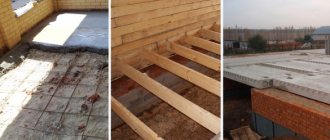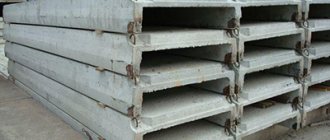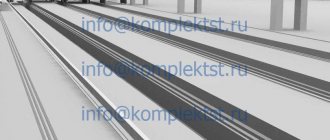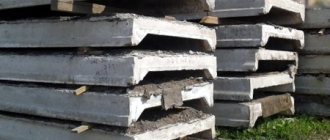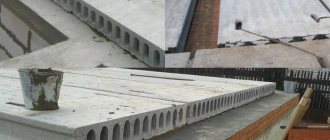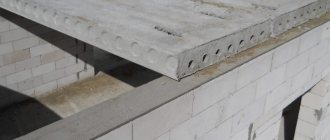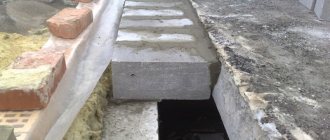Home |Blocks and floors |PB and PC floor slabs - what's the difference?
Date: March 13, 2017
Comments: 0
When carrying out activities related to the construction of residential buildings and industrial facilities, reliable reinforced concrete floors are used, installed between floors. At construction sites, similar-looking reinforced concrete products are stacked in stacks. It is difficult for the average person to find the difference between them. Only builders and designers can confidently distinguish PB floor slabs from externally similar PC slabs.
The products are used as connecting elements of building structures in the formation of interfloor sections of prefabricated and precast-monolithic buildings. Designers pay primary attention to the safety margin of floors, which affect the stability of the structure. In the construction of modern buildings, PC and PB floor slabs, which have much in common, are widely used. They are made of durable concrete, reinforced with prestressed reinforcement, and are resistant to fire and moisture. Air cavities effectively dampen noise and provide reliable sound and thermal insulation. However, there are differences.
A hollow-core floor slab (PC) is a flat rectangular concrete block
When dealing with construction issues, it is important to know how the products differ and what the technical characteristics are. Therefore, we will consider in detail the operational parameters of the products, and figure out what the difference is between them.
Varieties
Let's look at the features of the products used and labeling:
- PB floor slabs are manufactured using a formless method using specialized equipment using vibration compaction. The formation of products of the required length is ensured by cutting the concrete during the hardening process on a conveyor line with continuous movement of the concrete mass. The length into which the PB slab is cut depends on the customer’s requirements and is a maximum of 12 m.
- Products labeled PC are manufactured by filling metal formwork with reinforcing bars and mesh with concrete mortar. The molded frame is subjected to vibration compaction, heat treatment, and subsequent extraction of the finished product. The length does not exceed 7.2 m.
PC and PB boards have a significant difference due to the peculiarities of the manufacturing process cycle.
Currently, many types of hollow-core products are produced, which vary in the diameter of the voids and the shape of the slabs themselves
Production of PC boards
The technology for producing round-hollow PC slabs has existed for several decades. It is more focused on standard construction. These building materials have been used for many years, their practical characteristics and ability to withstand loads have been studied in practice and time-tested. There is a high proportion of manual labor in the technological process.
Such reinforced concrete products are manufactured in special metal forms - formworks. Reinforcing elements and void formers are installed in this form. Reinforcing mesh is located at the top and bottom of the product. The form is moved to the vibrating table. Concrete solution is poured into it. Concrete is taken class B15 and higher. The concrete is compacted in the vibro-electroform. The mold is covered with moisture-retaining material and heated for 7 hours. After this period of time, the workpiece is removed from the formwork, and the void formers are removed from it.
Characteristics of products marked with PB
PB floor slabs, produced by the method of permanent formation of a concrete mass without the use of formwork, are characterized by high technical indicators:
- increased noise insulation characteristics;
- ideal external surface;
- ability to withstand significant mechanical loads and shock impacts;
- significant margin of safety;
- possibility of use in different climatic zones;
- reduced weight;
- high thermal insulation properties;
- extended range of product lengths, due to the peculiarities of manufacturing technology;
- the presence, if necessary, of an oblique cut of the end surface;
- resistance to penetration of moisture into the depths of the concrete mass, causing corrosion.
Upon visual inspection of the end part, it is easy to see that the PB slab is reinforced with cables. The products are reinforced with durable steel reinforcement, providing increased strength properties. To understand how significantly the products differ from similar PC slabs, let’s consider the technical characteristics of the analogue.
The panels can be used on structures of any installation dimensions: the overall dimensions are so unified that they fit everywhere
Reinforcement of floor slabs
PC slabs, which you can buy from our company by calling 700-19-99, are reinforced with stressed steel reinforcement of classes At-IV, At-V and At-VI according to GOST 10884, as well as with non-stressed reinforcement A-II, A-III according to GOST 5781. If transverse reinforcement is required, then steel mesh is used.
PB slabs are strengthened with longitudinal reinforcement using prestressed high-strength steel ropes with a diameter of 9 to 12 mm.
If we talk about old and new methods of reinforcement, then PC slabs are classified as more outdated types than PB, the reinforcement of which is already subject to new construction requirements.
Properties of products designated PC
Products with the PC index have the following technical indicators:
- The production time is reduced to 14 days, which, accordingly, increases the cost of products, but reduces construction time.
- Can be used in all types of structures.
- Reinforcement with stressed or ordinary steel rods.
- Vibration resistance and reliable sound insulation, allowing to dampen significant vibrations and noise.
- Third group of crack resistance.
- Moisture resistant.
- Resistant to high temperatures.
- Equipped with mounting lugs for easy movement. This distinguishes the slabs from PB, which do not have sling elements.
Let's take a closer look at the distinctive points. Let's figure out how significant the differences are from slabs of similar purposes.
Since hollow-core floor slabs are intended for standard construction, they are marked during manufacture
Types of reinforced concrete floors
Monolithic flooring will require more time. This is due to the technological process: first you need to prepare the formwork, then tie the reinforcement and only then pour the concrete. But, of course, wait a while for the concrete to harden. Overlapping with slabs occurs much faster. In advance, even at the design stage, in the sketch, the slabs must be laid out. Thus, calculate the number and corresponding size of the slabs. Next, you order the material from the factory. It is advisable to lay out the slabs immediately after delivery. To do this, you hire competent workers (who will do their work taking into account all construction standards) and special equipment. The layout happens literally in a matter of hours.
Advantages of formless products
PC and PB slabs have much in common, but there is a significant difference. The main advantages of formless floor slabs from those formed in frames are the following:
- improved quality of the external surface of the product. To ensure flatness, special equipment is used that operates continuously, forming a smooth surface. The products are easy to distinguish from PC slabs that have significant irregularities;
- clear geometric dimensions, ideal shape, facilitating the implementation of construction activities related to the installation of products;
- the use of advanced manufacturing technology with cable reinforcement, which eliminates the surface tension factor that causes cracks;
- the ability to manufacture products of various dimensions (2-12 m), ensuring accuracy up to 0.1 m;
- extended range of perceived forces, depending on the size of the products and amounting to 0.6-1.45 t/m²;
- the presence of prestressed reinforcement in the concrete mass (for any product dimensions);
- the ability to form the end part of the product at different angles;
- easy creation of communication holes in the concrete mass.
The PB slab requires a special rigging device to perform slinging. This difference creates certain inconveniences during transportation. This product differs from PCs equipped with mounting brackets.
Production of PB boards
The technology for manufacturing formless PB slabs is completely different. It is considered more progressive, focused on individual construction. The range of such slabs is wider, and there is greater variation in their dimensional parameters. It is possible to produce PB slabs according to the customer’s design. The formation of products takes place on a special long stand. Reinforcement is installed there and is strained. It is located in one row, parallel to the long side of the slab. The stand is pre-coated with a compound that prevents concrete from sticking.
Void formers are installed. Concrete mixture is applied to the moving line. Concrete is used class B30 and higher. The stand is heated, the workpiece reaches the required strength. Then it is cut into pieces of the required length. Using a special saw, you can cut the ends not only parallel to the width of the product, but also at different angles. The slab released from production undergoes quality control.
Choosing: cheap or high quality?
When choosing building materials, in particular reinforced concrete products, you can, of course, save a couple of thousand by purchasing floor slabs from a handicraft manufacturer. But it should be understood that only factory production guarantees compliance with the technological process. Starting from high-quality concrete, because concrete science is a whole science, observing proportions, pouring and drying technology (and in large industries, also steaming). The metal from which the internal reinforcement of the floor slab is made also plays an important role. The steel grade must meet certain characteristics in order to withstand the stated load. It follows from this that only a competent technologist at a large, time-tested plant can monitor the entire technological chain, observing all standards. Therefore, if you want to get an excellent material made in accordance with GOST, with a smooth surface, from high-quality concrete, choose floor slabs made in the factory using modern equipment. This will allow you to avoid additional investments in the further construction of your home. And remember: The miser pays twice!
Types and sizes of solid single-layer slabs
Plates - 1P and 2P
Description
Floor slabs of this type are divided into two types:
- 1P - product thickness 12 cm;
- 2P - product thickness 16 cm - marking.
As a rule, in the case of using these reinforced concrete structures as interfloor ceilings, the lower side serves as the ceiling and is ready for further finishing, the reverse side plays the role of the floor. The design provides mounting loops.
Manufacturing technology
Concrete grade B15 and higher is used to form the slab. For reinforcement, a frame made of steel reinforcement is installed inside. Concrete is poured into molds with pre-laid reinforcement. The option for supporting the product depends on the type of reinforcement and can be 2-, 3- or 4-sided.
Mold for the production of 2P plates.
Purpose
This universal product is used for the installation of interfloor slabs in multi-storey buildings and public buildings. It is used for laying heating mains, installing fencing for underground passages, canals, individual development, in industrial, road and housing construction.
Installation of solid slabs.
Marking
Products are designated by digital and letter indices. The first group includes letters indicating the type of construction (P) and numbers indicating the length in decimeters. The second digital group of designations is the width of the overlap in decimeters. The third group contains parameters of the concrete strength class.
An example of marking a solid slab: P 60-12-3.5.
Explanation:
- P – solid slab;
- 60 – length 6 meters, or 60 decimeters, or 600 cm;
- 12 – width of the reinforced concrete structure – 1.2 meters, or 12 decimeters, or 120 cm;
- 3.5 – made of concrete of strength class B3.5.
Dimensions
The standard sizes of slabs of this type are shown in the table.
Table 2. Standard sizes of slabs of type 1P and 2P
| Slab size | Coordination dimensions of the slab, mm | Slab weight (reference), t | |
| Length L0 | Width b0 | ||
| Plates type 1P | |||
| 1P 30.48 | 3000 | 4800 | 4,3 |
| 1P 30.54 | 5400 | 4.9 | |
| 1P 30.60 | 6000 | 5.4 | |
| 1P 30.66 | 6600 | 5.9 | |
| 1P 36.48 | 3600 | 4800 | 5.2 |
| 1P 36.54 | 5400 | 5.8 | |
| 1P 36.60 | 6000 | 6.5 | |
| 1P 36.66 | 6600 | 7.1 | |
Note: To find out the data for products of type 2 P, instead of 1, you must put 2 in the marking.
Ribbed floor slabs
Description
Ribbed floor slabs are capable of withstanding severe operational loads transmitted to load-bearing walls and other supporting structures. Load-bearing capacity parameters can vary and range from 400 to 500 kilograms per square meter of area.
A design feature of products of this type is the presence of stiffeners along the longitudinal axis. They provide high resistance to vibration loads, which makes it possible to use products in regions with increased seismological activity. These same ribs act as a supporting platform for installing slabs on the walls.
Purpose
Ribbed floor slabs are intended for creating floors on multi-storey industrial and public facilities, as well as for creating flat roofs. They are practically not used by individual developers, since the structural features of the products make the preparation for their installation and subsequent finishing more labor-intensive and expensive.
Depending on the area of use, ribbed slabs are divided into subtypes:
PP - used for installation of roofs of buildings without attics. Their distinctive feature is the absence of openings in the shelf; they are released overstressed.
Ribbed PP boards.
PG – additional slabs, in the manufacture of which non-stressed reinforcement is used.
PG stove.
PR - products are characterized by the presence of unstressed reinforcement in the frame and are used to create floors in structures.
PV – ribbed slabs with an opening in the flange. Designed for installation of a ventilation shaft or roof fan.
PV plate.
Advantages of building materials
Many professional builders point out that due to innovative methods for manufacturing floor slabs for multi-story buildings with the PB label, they have great potential. For example, the length of the reinforced concrete product itself may be non-standard, which will allow the customer to vary the types of slabs with dimensions of 1.8-9 meters.
An important factor is reducing the weight of PB products to 5-6%, which is impossible without the use of a formless production method. We talked above about the possibility of sawing the material, which allows them to be used to cover bay windows.
Slabs created using the constant formation of concrete mortar without the use of formwork have the following set of technological characteristics:
High margin of noise insulation.
Smooth and smooth outer surface of products.
Withstands impressive mechanical and shock loads.
Excellent safety margin.
Use for construction even in the most extreme climatic regions.


